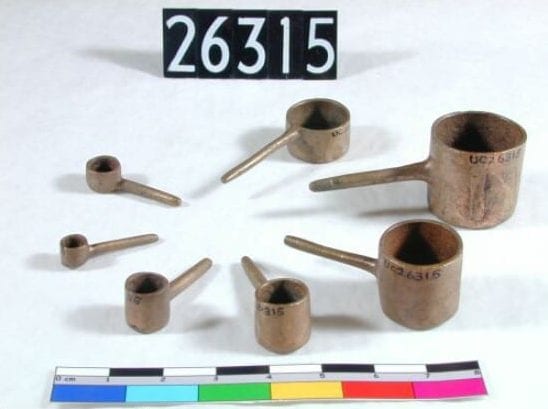Measuring the Past: The importance of standards from the Egyptians to the present
By Mark V Kearney, on 29 March 2019
During my previous shift at the Petrie Museum one object took most of my attention – a set of seven cylindrical bronze measures. I noticed them for two reasons, the first being that they are incredibly well made, especially the smallest which is only 5 mm in diameter. The second reason is that even in the 18th Dynasty (about 3500 years ago) the Egyptians understood the concept of standardization.
Our entire lives are guided by some kind of standard measurement – megabits, mp3, 5G, ounce, and of course the International System of Units. For those of you who don’t believe that working from a common standard set of units is important, allow me to remind you of just how costly it can be to mix things up. In September 1999 NASA’s Mars Climate Orbiter crashed into the side of Mars because one group of workers used non-SI units. A mistake costing $327.6 million.
It seems rather mindless that Egyptians living 3500 years ago understood this, yet we continue to make silly mistakes. The founder of the Petrie Museum, William Matthew Flinders Petrie, was keenly aware that in any high functioning society a set of standards would be both vital to its success and a central part of the daily lives of its citizens. In his book Ancient weights and measures, published in 1926, he notes that “we have now at University College over four thousand weights, or about two thirds of all Egyptian weights known”. This staggering claim highlights the importance of the museum’s collection. What is even more staggering is the sheer range and sub divisions which they had standardized — almost rivalling our own system today.

Figure 2 – Another example of a measuring device from the Petrie Collection. (Petrie Museum, UC7093)
Originally, those seven bronze measures would have measured gold dust in the Deben unit. The largest holding ½ a Deben, or approx. 11.8 grams today. However, as with many things, over time their meanings change, and during the New Kingdom, a Deben was changed to signify approx. 91 grams.
This change isn’t unlike our own modern struggles with the kilogram, a unit whose precise value had been changing ever so subtly since its mass was first defined in 1886 with Le Grand K – a cylinder of a platinum alloy which is carefully kept in Paris, France. However, basing a standard off of a physical object found only here on Earth rather than a universal constant is suboptimal to say the least. As an example, if someone in Canada wanted to know precisely what mass their object was in relation to a standard kilo they either had to send it to be measured directly against Le Grand K in France or off its copy, which may or may not be identical to Le Grand K. This leads to a lot of uncertainty, and while it might not affect the successful procrastibaking of a certain PhD’s scones (p.s – cake flour works wonders!), it does affect the highly precise measurements of certain scientific professions, as other units are also based of its value.
Figure 3 -The old units, some of which, like a mole, were based on the mass of Le Grand K (Source :Wiki)
Figure 4 – The new standards, where kg is governed by Planck’s constant Source: Wiki)
With this in mind, the group in charge of defining a kilo have changed its definition by defining the Planck constant to be exactly 6.62607015×10−34 kg⋅m2⋅s-1. The means that in May of this year, when the new standards take effect, a kilogram is no longer the mass of some lump of Platinum in a lab in France, but dependant on time and length, both of which are themselves defined by a universal constant.
From measuring mass using set volumes — which is what those seven vessels in the Petrie do — we now measure a kilogram with something called a Kibble Balance. This balance, which can be manufactured anywhere in the world, uses the newly defined value of Planck’s constant to measure the mass of objects to a level where uncertainty no longer has a negative effect — though to be fair, it doesn’t look as nice as the bronze cups, so there is still some work to do!
 Close
Close


